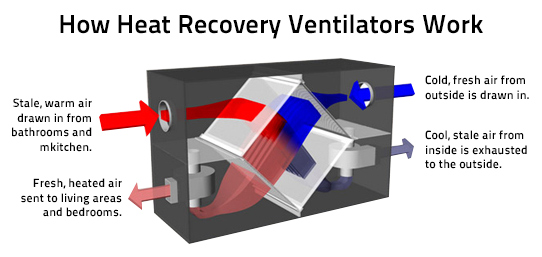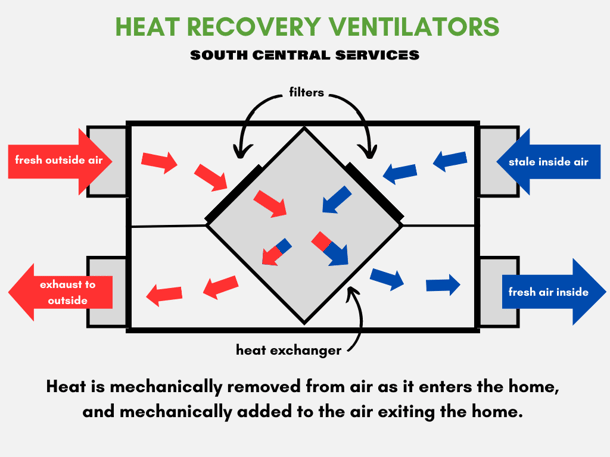Frequently Asked Questions About HRV Answered
Wiki Article
Unveiling the Trick Advantages and Uses of Heat Recovery Ventilation in Lasting Design
Heat Recovery Ventilation (HRV) systems play a vital role in lasting style. They help with a continual exchange of stale indoor air with fresh exterior air, considerably improving interior air top quality. HRVs contribute to energy effectiveness by reclaiming warmth from tired air, which can lower energy costs. Comprehending the multifaceted benefits and applications of HRVs discloses their importance in modern design. What various other benefits do these systems supply in the pursuit of sustainability?Recognizing Heat Recovery Ventilation Equipments
Heat recovery ventilation (HRV) systems are designed to improve interior air quality while decreasing energy loss. These systems utilize a mechanical air flow technique to exchange stale interior air with fresh outdoor air, making certain a continuous supply of tidy air. By catching heat from the exhaust air, HRVs prerequisite incoming air, reducing the demand on heating and cooling down systems. This procedure not just enhances thermal convenience but additionally adds to energy performance in household and business structures. In addition, HRV systems help control moisture degrees and minimize interior toxins, promoting a healthier living atmosphere. Their calculated application is crucial for accomplishing lasting design goals, as they provide a balance in between power conservation and resident health.Just How HRV Equipment Work
While several may be familiar with ventilation systems, recognizing just how warmth recovery air flow (HRV) systems run is crucial for valuing their advantages. HRV systems operate by exchanging stagnant interior air with fresh outdoor air while moving heat in between the 2 streams. This procedure occurs in a warmth exchanger, where heat from the outgoing air heats the inbound air during cooler months, minimizing energy loss. On the other hand, in warmer months, the system can cool incoming air using the cooler outbound air. HRVs are geared up with fans to facilitate air movement and filters to eliminate particulates, making sure a constant, well balanced ventilation procedure. This ingenious style not only boosts power effectiveness but also adds to preserving a comfy indoor environment.Enhancing Indoor Air Top Quality
Indoor air top quality can substantially affect health and wellness and health, making reliable ventilation vital in modern-day homes. Heat Recovery Ventilation (HRV) systems play an important duty in keeping interior air high quality by continuously exchanging stale interior air with fresh outside air. This procedure not only lowers airborne toxins but likewise minimizes moisture levels, which can cause mold development and respiratory system problems. HRV systems filter incoming air, getting rid of irritants and particulates, thereby giving a healthier living setting. Furthermore, these systems aid remove odors and volatile organic compounds (VOCs) generally discovered in house products. By ensuring a consistent flow of clean air, HRV systems add to a general better interior atmosphere, promoting convenience and well-being for occupants.Power Effectiveness and Price Financial Savings
Energy performance attracts attention as a substantial benefit of Heat Recovery Ventilation (HRV) systems. By recording and recycling the warm from exhausted indoor air, HRVs decrease the energy required for heating inbound fresh air, resulting in decreased power consumption. This effectiveness equates into lower energy costs, offering considerable price financial savings for homeowners and companies alike. Additionally, HRV systems commonly receive energy performance rewards and refunds, further improving their financial allure. Over time, the first financial investment in HRV technology can bring about a positive return on financial investment via reduced energy costs. The integration of HRV systems not just promotes sustainable layout but additionally gives a useful service for attaining long-lasting power financial savings and economic advantages.Environmental Benefits of HRV

A wide variety of ecological advantages develops from the application of Heat Recovery Ventilation (HRV) systems. By successfully moving warmth from exhaust air to inbound fresh air, HRVs considerably reduce the power required for home heating and cooling rooms. This power effectiveness equates to decrease greenhouse gas discharges, adding to a decline in the total carbon footprint of structures. Additionally, HRV systems boost indoor air high quality by constantly distributing fresh air, therefore reducing the concentration of indoor contaminants and irritants. The decrease in energy usage aids in preserving natural resources, making HRVs a vital component of sustainable layout. On the whole, the environmental advantages of HRVs play a crucial function in promoting a much healthier earth and promoting eco-friendly structure practices.
Versatile Applications in Modern Style
Heat recovery ventilation (HRV) systems are increasingly being incorporated into both property and industrial architectural projects. In property setups, HRVs boost indoor air quality while making best use of power performance. On the other hand, in commercial spaces, these systems enhance ventilation methods, showing their convenience in modern-day architectural applications.Residential Projects Integration
While modern-day style significantly emphasizes sustainability, the assimilation of heat healing air flow systems in residential projects has actually emerged as a functional option for boosting interior air high quality and energy performance. These systems effectively transfer warmth from exhaust air to incoming fresh air, reducing energy loss and minimizing home heating or cooling demands. In brand-new builds and retrofits alike, heat healing air flow can be seamlessly included, giving property owners with a much healthier living setting while reducing utility expenses. In addition, with raising recognition of environmental influences, even more engineers like it and builders are acknowledging the long-lasting advantages of these systems. Consequently, warm recovery air flow has ended up being an important component of sustainable domestic design, showcasing convenience and commitment to environmentally friendly methods.Commercial Rooms Optimization
As modern commercial spaces develop to meet the needs of sustainability and performance, the application of heat recovery air flow systems emerges as a key approach for maximizing interior atmospheres. These systems help with the exchange of stale interior air with fresh outdoor air while reclaiming heat, significantly minimizing power intake. This not just improves convenience for occupants however also assists in reducing functional prices. Functional applications can be observed in offices, retail rooms, and instructional organizations, where air quality and temperature level control are paramount. Additionally, incorporating warm recovery air flow lines up with eco-friendly building accreditations, better advertising ecological responsibility. Eventually, adopting such systems in industrial design not just adds to sustainability objectives yet likewise promotes much healthier, much more effective spaces for users.
Integrating HRV Into Sustainable Style Practices
Integrating warmth recovery ventilation (HRV) systems right into sustainable layout practices provides considerable benefits in power effectiveness and indoor air top quality. By using HRV, developers can produce cost-effective options that not just minimize power usage however additionally improve the overall comfort of interior environments. This positioning with sustainability objectives settings HRV as an essential component in modern-day building methods.
Energy Efficiency Improvement
By including heat healing air flow (HRV) systems right into sustainable layout methods, designers and contractors can substantially improve energy performance in contemporary buildings. HRV systems function by recording warmth from outbound stagnant air and transferring it to inbound fresh air, reducing the energy needed for heating or cooling down interior rooms. This process not only lowers reliance on typical cooling and heating systems however additionally lowers overall power intake. Additionally, HRV systems can aid keep a constant indoor temperature, lowering peak energy demands. By incorporating these systems, buildings can accomplish significant reductions in utility costs and carbon impacts, lining up with sustainability objectives. Ultimately, HRV technology stands for a practical remedy for boosting energy efficiency in the constructed environment, promoting more accountable source use.Indoor Air Top Quality Enhancement
How can warmth recuperation air flow (HRV) systems add to superior indoor air high quality in modern structures? HRV systems efficiently exchange stale interior air with fresh outdoor air while recuperating warmth power, website link minimizing temperature variations. This process minimizes the focus of interior pollutants, such as volatile natural substances (VOCs), allergens, and dampness, which can wear away air top quality and impact owner wellness. By maintaining excellent moisture levels and making certain a continual supply of clean air, HRVs aid produce a much healthier interior environment. In addition, these systems can be integrated right into sustainable design techniques, advertising energy performance along with enhanced air quality. HRV Heat Recovery Ventilation. Subsequently, HRV modern technology plays an important function in progressing general passenger convenience and health in modern architectural stylesAffordable Layout Solutions

Often Asked Inquiries
What Maintenance Is Needed for Heat Recovery Ventilation Solutions?

Upkeep for warmth recuperation air flow systems generally entails routine filter substitutes, cleansing of warmth exchangers, assessment of followers and air ducts, and ensuring proper drain. These jobs help maintain efficiency and extend the system's lifespan gradually.
Can HRV Equipments Be Installed in Existing Buildings?
Heat recovery ventilation systems can certainly be set up in existing buildings. HRV Heat Recovery Ventilation. Retrofitting calls for cautious preparation and evaluation of the building's format, guaranteeing compatibility with existing systems while making best use of energy effectiveness and interior air high qualityHow Do HRV Solution Influence Noise Levels Indoors?
HRV systems can affect indoor noise degrees by introducing noise from outside sources through ventilation. Top quality installations commonly integrate sound-dampening features, decreasing sound influence while supplying efficient air exchange and preserving convenience indoors.Exist Any Drawbacks to Using HRV Solutions?
The disadvantages of making use of HRV systems consist of prospective high initial costs, upkeep obstacles, and the possibility of reduced interior air quality if filters are not regularly changed, which can bring about problems with moisture levels.Exactly how Do I Select the Right HRV System for My Needs?
Choosing the appropriate heat recovery air flow system involves evaluating details requirements, such as constructing dimension, climate, and energy efficiency objectives. Additionally, evaluating system attributes, installation demands, and maintenance considerations is necessary for peak performance and satisfaction.Report this wiki page